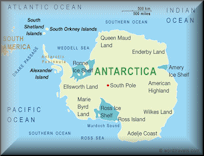-
-

Please Wait...
-
.com.aq Antarctica Domain Country Information - .com.aq Antarctica Country Information
.com.aq

Price and Requirements for .com.aq Domains
![]()

.com.aq Antarctica Country Information
Antarctica is Earth's southernmost continent, encapsulating the South Pole. It is situated in the Antarctic region of the Southern Hemisphere, almost entirely south of the Antarctic Circle, and is surrounded by the Southern Ocean. At 14.0 million km2 (5.4 million sq mi), it is the fifth-largest continent in area after Asia, Africa, North America, and South America. For comparison, Antarctica is nearly twice the size of Australia. About 98% of Antarctica is covered by ice that averages at least 1 mile (1.6 km) in thickness.
Antarctica, on average, is the coldest, driest, and windiest continent, and has the highest average elevation of all the continents.[6] Antarctica is considered a desert, with annual precipitation of only 200 mm (8 inches) along the coast and far less inland. The temperature in Antarctica has reached −89 °C (−129 °F). There are no permanent human residents, but anywhere from 1,000 to 5,000 people reside throughout the year at the research stations scattered across the continent. Only cold-adapted organisms survive there, including many types of algae, animals (for example mites, nematodes, penguins, seals and tardigrades), bacteria, fungi, plants, and protista. Vegetation where it occurs is tundra.
Although myths and speculation about a Terra Australis ("Southern Land") date back to antiquity, the first confirmed sighting of the continent is commonly accepted to have occurred in 1820 by the Russian expedition of Fabian Gottlieb von Bellingshausen and Mikhail Lazarev. The continent, however, remained largely neglected for the rest of the 19th century because of its hostile environment, lack of resources, and isolation. The Antarctic Treaty was signed in 1959 by 12 countries; to date, 47 countries have signed the treaty. The treaty prohibits military activities and mineral mining, prohibits nuclear explosions and nuclear power, supports scientific research, and protects the continent's ecozone. Ongoing experiments are conducted by more than 4,000 scientists from many nations.
Antarctica is divided in two by the Transantarctic Mountains close to the neck between the Ross Sea and the Weddell Sea. The portion west of the Weddell Sea and east of the Ross Sea is called West Antarctica and the remainder East Antarctica, because they roughly correspond to the Western and Eastern Hemispheres relative to the Greenwich meridian.
About 98% of Antarctica is covered by the Antarctic ice sheet, a sheet of ice averaging at least 1.6 km (1.0 mi) thick. The continent has about 90% of the world's ice (and thereby about 70% of the world's fresh water). If all of this ice were melted, sea levels would rise about 60 m (200 ft). In most of the interior of the continent, precipitation is very low, down to 20 mm (0.8 in) per year; in a few "blue ice" areas precipitation is lower than mass loss by sublimation and so the local mass balance is negative. In the dry valleys the same effect occurs over a rock base, leading to a desiccated landscape.
.com.aq Antarctica Domain Name - Country Information
| Country Domain | Antarctica Domain Name .com.aq |
|---|---|
| Country Information | Antarctica Domain Country Information .com.aq |
| TLD Bulk & Advanced Search | Antarctica Bulk Domain Registration .com.aq |
| WhoIs Server | .com.aq Whois Server Information |
| Domain Renewals | Renewal Antarctica Domain .com.aq |
| Domain Transfer | Transfer Domain .com.aq |
| Domain Hosting | .com.aq Antarctica Web Hosting |
| SSL Certificates | SSL Certificates |
| Email Services | .com.aq Antarctica Email Services |
| Domain FAQ | .com.aq Domain Registration FAQ |
Antarctica Country Information Search Terms
Antarctica Domain Country Information Antarctica Domain Registrar Antarctica World Wide Domain Registration Antarctica Country Code Top Level Domain .com.aq Domain Information Antarctica Country Information Antarctica Country Information











